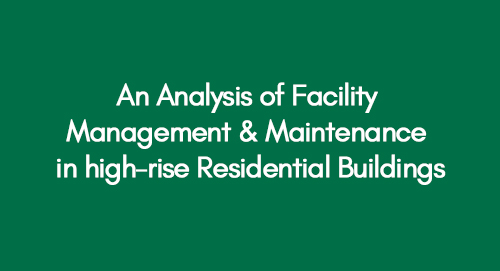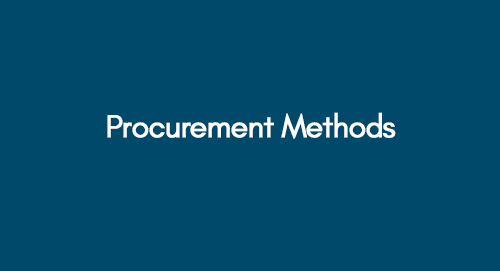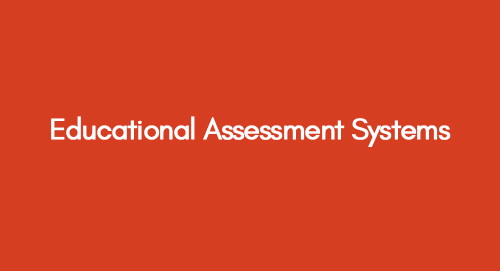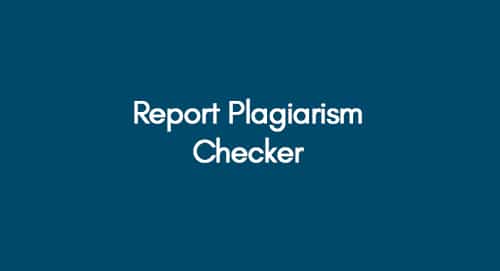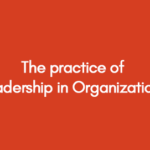
The practice of leadership in Organizations
December 24, 2020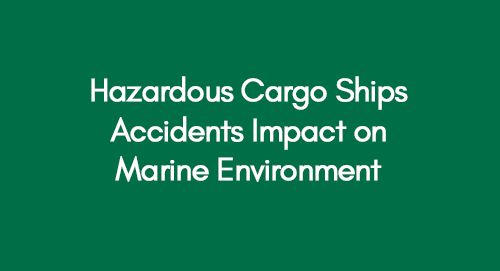
Hazardous Cargo Ships Accidents Impact on Marine Environment
December 24, 2020In high-rise residential buildings, the symbiosis of facility management and maintenance is pivotal—orchestrating seamless living for residents while ensuring the structural integrity that defines vertical communities. In the ever-changing urban landscape, high-rise residential structures emerge as contemporary masterpieces, aspiring to new heights and reshaping our perception of vertical communities. Beyond their impressive exteriors and panoramic vistas, the unsung heroes—facility management and maintenance—work diligently behind the scenes, playing a crucial role in defining the seamless interplay between resident contentment and the enduring sustainability of the building's structure.
Improving Occupant Safety in High-Rise Buildings
Unravelling the intricacies of this essential partnership unveils a symbiotic relationship that shapes the essence of modern living. Facility management takes the lead as the conductor of this vertical symphony, orchestrating the diverse elements that contribute to resident well-being. From coordinating amenities to implementing security protocols, every detail is thoughtfully curated to elevate the quality of life within these towering edifices. In tandem, maintenance acts as the silent guardian, ensuring the building's longevity and resilience. Together, these forces create a harmonious synergy that not only addresses the immediate needs of occupants but also fortifies the foundation upon which the vertical community thrives.
Introduction
This report delves into the analysis of facility management and maintenance within the context of high-rise residential buildings, a burgeoning living standard in contemporary times. The report is divided into two primary sections: the main body and the conclusion and recommendations.
The focal point of this study is the Ardmore Group, a prominent construction company engaged in the development of high-rise residential, commercial, and educational structures. Boasting a forty-year legacy, the Ardmore Group has an extensive portfolio of successful projects, both completed and ongoing. While the company has undertaken various construction ventures, this report specifically concentrates on high-rise residential buildings constructed over the past two decades. Despite the company's widespread ownership of such buildings nationwide, the analysis zeroes in on a specific location to pinpoint potential issues in the current approach to facility management.
Building Conservation and Adaptation
The researcher's objective was to explore the fundamental concepts of facility management and building maintenance to establish foundational insights. To achieve this, two sizable multi-story residential building blocks were scrutinized in this research. Additionally, meetings were conducted with representatives from the Ardmore Group and residents of the buildings under consideration. These interactions provided valuable insights into the current practices employed by industry professionals, which are succinctly outlined in the subsequent sections of this report.
Facility Management
Facility Management (FM) encompasses a blend of diverse disciplines focused on the efficient management of spaces, residents, organizations, and infrastructure across various building types, including residential, health, educational, professional, and commercial structures. The International Facility Management Association characterizes FM as a profession that integrates numerous disciplines to ensure the proper construction of environments through the collaboration of people, place, process, and technology (Good Practice Guide on Facilities Management, 1998).
Described as an integrated practice, Facilities Management (FM) involves working, maintaining, improving, and adjusting the infrastructure and buildings of a company to facilitate the achievement of its primary goals within the built environment (Atkin & Brooks, 2000). FM is viewed as a hybrid management discipline, combining expertise in people, property, and process management to provide support for the overall functioning of the company (Then, 1999). While various definitions of facility management exist, they consistently emphasize the importance of managing the interaction between humans and the physical environment to ensure the effective operation of the company (Gagendran, 2000).
An illustration for FM is given below:
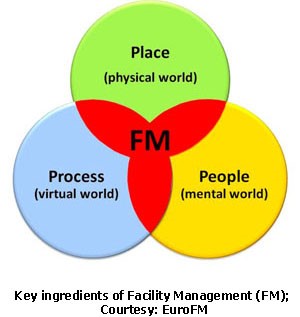
Core Competencies of Facility Management
In 2009, a Global Job Task Analysis (GJTA) conducted by the International Facility Management Association (IFMA) identified 11 core competencies for Facility Management (FM). The insights were gathered from 62 countries, making these competencies a globally recognized framework. The 11 competencies delineated by IFMA are:
- Communication
- Emergency Preparation and Business Stability
- Environmental Stewardship and Sustainability
- Investment and Business
- Human Factors
- Leadership and Strategy
- Operations and Maintenance
- Project Management
- Property Management and Real Estate
- Technology
- Quality
FM encompasses a broad spectrum of activities, including workstation management, capability enhancement, support services, asset management, commercial real estate, and organizational considerations (Ancarani and Capaldo, 2005). The literature has presented various classifications of FM services, and based on the latest findings, the following table has been constructed to delineate FM services (Alexander, 1992):
Table 1: FM services overview
| Hard FM | · Mechanical and Electrical maintenance (M&E) · Changes in infrastructure · security and fire · plant cultivation · Landscape preservation · Building fabric refurbishment |
| Soft FM | · Cleaning services · Help desk · Telecommunication · Transpiration · Warehouse management |
| Business support services | · Property management · Information and Communication Technologies (ICT) · FM management and contracts · Human resource management |
With the surge in population, effectively managing residential areas has become a challenging task (Waheed, 2009). Additionally, there is a growing inclination among people to reside in upscale areas or buildings equipped with advanced facilities. Living in high-rise buildings has emerged as a popular trend worldwide. Individuals with the means to afford a home often prefer the convenience and amenities provided in high-rise buildings. These structures may consist of multiple units within the same area. The choice of residing in high-rise buildings is often driven by individuals willing to pay substantial fees for the prime locations and comprehensive services offered by the owning company.
With the increase in the population, it is hard to manage residential areas effectively (Waheed, 2009). Moreover, people are inspired to live in a high profile area or buildings where all advanced facilities are available. Living in high-rise buildings has become a trend for people of all countries. All those people who can afford a house prefer to live in high-rise buildings where they are accommodated with many services. A high-rise building can be multi-unit which means having the same buildings within the same area. It is observed that people choose high-rise buildings as their residences because they pay enough fees for the locations and services, which are offered by a company that owns that building.
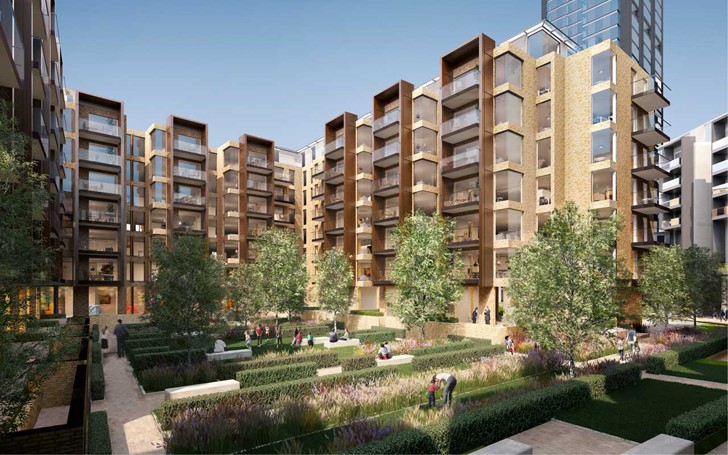
Figure 2: high-rise residential buildings
Case Study Analyses: Current Facility
This examination delves into the existing facility's operational dynamics, scrutinizing its management practices, resource utilization, and overall effectiveness. The analysis aims to identify strengths, weaknesses, and potential areas for improvement within the current facility framework.
Management Strategy
Facility management in diverse building types is subject to distinct definitions, with residential buildings, in particular, requiring a framework tailored to their unique needs. High-rise residential structures, unlike commercial office buildings, exhibit distinct associations, sentiments, and relationships as they serve as living spaces (Atkin and Bjork, 2007). Consequently, the components of facility management for high-rise residential buildings deviate significantly from those applicable to other building types.
The development of Facility Management (FM) strategies varies across companies, and in the case of the Ardmore Group and its associated partners, extensive involvement in high-rise residential projects across various UK cities is evident. The literature emphasizes the vital role of organizational support for effective facility management. The chosen case study for this research offers a brief review of Limehouse Basin (London), owned by Bellway Homes, and a scheme comprising 50 affordable homes near London's Charterhouse Square, under the ownership of Thornsett Group and falls under the local authority of Islington.
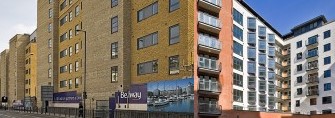
Figure 3: Research Focus; Limehouse Basin & Charterhouse Square
The company has developed the following strategy of facility management for high-rise residential buildings based on their business nature and experiences;
Table 2: Brief Review of Buildings
Building types
| Components | Performance characteristics | Hard FM components | Fabric maintenance implications |
Residential And Commercial
| Foundation Walls Floor Ceilings Doors Windows Stirs Elevators Sanitary Electrical supply Parking areas Shared spaces | Continuous monitoring Energy efficiency Indoor thermal behaviour thermal-energy performance thermal-energy assessment
| Mechanical and Electrical maintenance (M&E) changes in infrastructure security and fire plant cultivation Landscape preservation Building fabric refurbishment | Main fabric(walls, floor, roof, windows) internal finishes(ceiling and wall finishes) special architectural design features(decorative elements) cleaning and housekeeping |
Literature indicates that high-rise residential buildings generate higher amounts of greenhouse gases compared to other building types. The correlation between building height and energy consumption is evident, primarily attributed to shared spaces within high-rise residential structures. The key sources of energy consumption for these buildings were identified as follows:
Table 3: Sources for electricity consumption high-rise residential buildings
Shared space | Individual space |
· Lifts · exterior lighting · Lighting shared spaces · Hot water supply and circulation pumps · Carpark ventilation · HVAC drain pans · Water pool and water filtration and pumps · Security systems · Cooling tower pumps · Cold /hot water supply | · Interior lighting · Heating and cooling for individual apartment · Home appliances |
During this research, it was observed that the client operates different buildings, some of which were constructed more than 10 years ago. Therefore, it was also important to analyse the primary difference between the new and old buildings;
Table 4: Comparison of old and new buildings in the Client organization’s portfolio
Building type | Old | New |
Residential & Commercial
| Use of hazardous material for constructing | Reduced safety problems |
Maintenance/Refurbishment of old buildings is expensive | efficient in terms of heating and air conditioning | |
Special rules to perform maintenance | affordability, transport links, play | |
Consume more energy | more energy efficient | |
Complex structure | Easy going structure |
The key points/aspects regarding the facilities management observed in this case study have been outlined/summarized in a tabulated form below;
Table 5: Current FM strategy of the client company
Component | Description |
Energy
| It was difficult to analyze the current energy efficiency of the building being investigated; however, it was observed that various alterations can optimize the energy performance of such buildings. The actual high-rise residential buildings require more consumption of energy than other housing schemes. This is due to the fact these buildings share many areas. Therefore, such buildings require an integrated approach to enhance energy performance, which was lacking in this particular case and service and managing energy consumption is an important concern for high-rise residential buildings. |
Water
| Water ingestion and effectiveness are considered key pointers for building performance. It is observed that water-efficient buildings are in demand by the public and government for their operations. In the current practices of the company, water resources are not that efficient because of ad hoc management techniques. |
Waste
| Waste reduction is taken as a very important factor for a healthy and sustainable environment. In the case of high-rise residential buildings, waste reduction is challenging the company is striving to maintain cleanliness and prevent the outflow of harmful materials. |
Maintenance
| Enhancing building performance is important for a sustainable environment, however, the company does not implement any strategy that evaluates the performance of the maintenance teams |
Safety
| Facility Managers ensure that safety for residents, visitors and contractors ensues in these buildings. Although some signs have been installed in the buildings investigated, further active fire protection systems, as well as safety signs, must be installed for this high-rise residential building of the company. |
Dangerous Possessions
| Harmful materials which are often used for cleaning and other purposes need to be managed effectively so that these do not generate any negative impact on the environment. No such checks were observed during the analyses of the current FM |
Hazardous Materials
| All those materials, which are harmful to human health, may be found in high-rise residential buildings and all these need safe storage. For now, the company has maintained a store but it did not put a policy for their use |
Health & Convenience
| For the residents of high-rise buildings, it is vital to provide a healthy and adoptable living standard. The company needs to introduce the latest standards to inspire more clients |
Vital Services
| Fire and safety shield items are required for the residents of high-rise buildings. |
Emergency Management
| Emergency Management Plan, identification of high-risk areas and safe areas, maintenance schedule as well as an emergency training program is essential for high-rise buildings. For now, the company has a rough planning, which needs to be refined efficiently. |
Security
| The protection of physical infrastructure and assets is also a significant concern. The company has obtained services of external security services for the protection of its assets. Permission was not granted to gain information regarding the security plan |
Suggested FM Strategy and the SWOT Analysis
Proposing an effective Facility Management (FM) strategy involves optimizing resource utilization, enhancing operational efficiency, and ensuring the seamless integration of architectural technology. The strategy should prioritize sustainability, resident satisfaction, and cost-effective maintenance practices to create a holistic approach tailored to the unique needs of high-rise residential buildings.
Conducting a comprehensive Strengths, Weaknesses, Opportunities, and Threats (SWOT) analysis enables a nuanced understanding of the current facility management landscape. Identifying internal strengths and weaknesses and external opportunities and threats equips stakeholders with valuable insights to formulate strategic decisions and enhance overall facility management effectiveness.
Evaluations and Implications
The energy management process is considered to be one of the most important factors in a facility management plan (Noor and Pitt, 2009). An effective process for energy saving along with management practices can provide substantial cost benefits for organizations. Following are some major steps which should be part of the energy management process.
1. A review of current energy performance gives an idea for measurement and plans for energy management. |
2. Knowing about the energy needs of the building in different time slots by communicating with residents |
3. Energy audit is an imperative part of the energy management process. It makes sure that nothing is ignored. |
4. Identify available resources, energy baseline and opportunities with the addition of expectations of residents and budget limitations |
5. Maintain a system which keeps energy consumption records and reports |
A SWOT analysis is a planning tool which demonstrates Strengths, Weaknesses, Opportunities, and Threats that a business could face. Mostly it is used for strategic planning. It identifies business objectives as well as internal and external factors which are supportive of achieving objectives. SWOT is the first tool to know more about the situation (Helms and Nixon, 2010). The summary of the SWOT analyses completed for the client has been detailed below;

In the results of these analyses, the following are the suggested improvements that which client company can make regarding its facility management strategy.
Table 6: Suggested FM strategy in response to SWOT
Component | implications |
Energy
| · Identify and monitor meters and circuit supply and develop reports periodically. Assess the data obtained to engineer a more sustainable and effective method of energy management. This includes - Investigate levels of light in different locations and make comparisons with approved best standards of practices - Maintain Inventory for energy-consuming equipment - Analyse poor performance areas - Find out control systems and analyse the power factor |
Water
| · Improve a water baseline and available water profile · Collaborate with inhabitants · Define objectives · Deploy plans · Look into usage and identify leakage sources · Analyse performance and results |
Waste
| · Develop a waste management plan · Find out onsite waste disposal methods · Make effective garbage collection policies · Make sure recycling waste reduction is lower · Make sure recycling space is available · Organize a space for hard waste and charity materials · Try to reduce mess and noise during waste collection and disposal |
Maintenance
| · Identify goals and objective · Recognise strategies · Define resources · Prepare required documentation · Measure progress |
Safety
| · Define major goals · Identify critical areas · Communicate with residents · Prepare a safety plan |
Dangerous Possessions
| · Identify the type and volume of the material and manage their reduction · make sure enough space is available for their storage and discrimination · Availability of spill kits for cleaning oil and diesel and Material Safety Data Sheets (MSDS) · chemicals storage without ant odour · Availability of locked metal fireproof cabinet · add usage of dangerous goods into a contract of residents which they use |
Harmful Materials
| · Make sure harmful materials are stored in a safe place |
Health & Convenience
| · Improved inside environment and lighting · heat and space management · noise avoidance · ecological transport availability |
Vital Services
| · Air conditioning systems · Emergency lifts, lighting and power supply · Mark exit doors · Develop fire control centres and alarm systems · Separate stairs and windows during a fire · Smoke alarms and smoke control system |
Emergency Management
| · Make sure the evacuation plan is demonstrated · complete site plan is displayed · Presentation of the existing fire safety statement · Organise fire response training |
Evacuations
| · Emergency Management Plan is investigated before implementation · Make sure evacuation time is less as possible |
Security
| · Advanced security cameras · Improved lighting facility and traffic management · investigation and reduction of simple accessible · training for residents |
Sustainability is a crucial consideration for high-rise residential buildings, encompassing design, infrastructure, and operational strategies with minimal environmental impact and promoting resident well-being. Evolving over the past decades, sustainability standards once viewed as optional are now essential, reflecting heightened client expectations and awareness. Stakeholders prioritize a sustainable environment, with key principles for sustainable architecture design, including efficient energy and water use, waste reduction, environmental preservation, material conservation, improved indoor environments, enhanced landscaping, and community engagement (Mallen and Chard, 2012).
The client company, with an extensive portfolio of high-rise buildings, necessitates a strategic sustainability plan for these structures. Factors influencing sustainability decisions in high-rise residential buildings include:
- Livability: Efficient building design directly impacts indoor air quality, linking to improved air quality, productivity, and overall well-being.
- Economics: Sustainable designs result in significantly lower operational costs, offering long-term cost savings.
- Government Regulation: Government regulations mandate building performance standards, particularly for sustainable structures.
- Market Pressure: The trend towards incorporating sustainability in building design is driven by market demand, influencing stakeholders to adopt this approach.
- Awareness: Consumer awareness of sustainable environments obligates investors to prioritize sustainable building practices, minimizing negative environmental impact and fostering healthy living environments.
Corporate Social Responsibility (CSR)
CSR can be defined as the analysis of economic, legal, moral, social and physical aspects of the environment. Corporate Social Responsibility is a well-known concept in business reporting. Every organization has its own customized CSR policy, which is revised and reported annually. The more advanced definition of corporate social responsibility is described as an association between international companies and Governments. In simple words, CSR is considered as an association between a company and the society in which that company works. CSR also defines the relationship between stakeholders and the company. So there are multiple views on the definition of CSR.
According to the EU Commission (2002);
“CSR is a practice which is followed by companies to assimilate social and environmental concepts into their business operations and in their interaction with their stakeholders voluntarily.”
Principles of CSR
As it is hard and very uncertain to define CSR appropriately there is a need to follow concepts, which are supportive of CSR. These principles are described below: (Zawawi et al., 2011)
Sustainability: It stands for the possibility that actions taken in present could be available in future. When resources are limited and have been used in the present then these are not available for future use. Therefore it got a significant place in FM strategy development. For example, steel, concrete and timber are available in limited quantities and not available for future use. It may be possible that some alternatives are added to these sources depending on the needs. Therefore, in actuality if some resources are exhausted then the cost of attaining other resources increases, which ultimately causes a rise in the cost of operations of the organization.
Comparison of Timber and Steel Framed Buildings
Therefore, the Client Company needs to maintain sustainability such that resources should not be used more. In other words, this is the tendency of the ecosystem demonstrated in terms of input and output models of reserve depletion. For example, in the case of the paper industry, trees and plants are planted again, which have been harvested for paper production. This is done to save cast and effort. Sustainability could be measured from the rate of resource consumption to the production rate of consumption. There are also some unsustainable operations, which are managed by either introducing sustainable operations or making plans for the future. Normally companies including Client Company can increase the efficiency of the utilization of resources.
Accountability: It is related to the realization of the organization towards effects on the external environment as the result of some actions. In other words, accountability is concerned with knowing about affected groups (stakeholders). In broader terms, accountability states that an organization is not limited to only its owners but it is a part of a social network which could be affected by the actions of that organization. Moreover, stakeholders should also take part in the decisions of the organization while making action plans. They should also know that these actions are valuable for the organization or stakeholders. Therefore, accountability implies formulating strategies and reports to measure environmental presentation and informing organizations about those actions. The following features of reporting are investigated for accountability.
- All concerned parties have an understanding
- Significance to the users of the given evidence
- Consistency in the form of accuracy and freedom
- Comparability which demonstrates consistency for both time and diverse companies
These types of reports include qualitative evidence, decisions and quantifications as well.
Transparency: Transparency is also an important concern of CSR. It states that reporting of an organization determines the influence of its actions on the external environment including all open facts. Therefore all parties can know about all actions of the companies for whom reporting is available. External users are more dependent on transparency because they don’t have much information like internal users.
Implementation of CSR and Sustainability in Client Company
Client Company implements both CSR and sustainability somehow for its operations. Both of these practices are essential to enhance and improve the overall performance of the concerned company. Although there are still some loopholes which require improvements. Developing an FM strategy is a continuous process which evolves depending on the business needs. following are some factors which support the adoption of the above-mentioned principles of CSR and sustainability as well as some factors which does not support sustainability and CSR.
Encouraging Factors
- Competitive edge: An improved, well-defined and organized CSR and sustainability provides a significant place in the market. Both of these practices, facilitate the organization to compete with its competitors.
- Consumer satisfaction: Consumers are always looking for better opportunities and in the case of living; they seek the best place as their residence. A high profile high-rise building with all facilities inspires consumers to choose it as their residence.
- Increased revenue: Improved strategies and high-performance buildings cause an increased profit for client organizations which is a great benefit for achieving organizational objectives.
Discouraging Factors
- Increased cost: It is obvious that adding more services increases expenses that cause high costs which may not be affordable for many consumers.
- Market pressure: There are also chances of increased market pressure over client organization, which introduces new services.
- Consumer expectations: When a client organization offers new services it may happen in its next project consumers expect more than past.
Building Maintenance
Maintenance is described as an amalgamation of technical and related administrative tasks that are needed to maintain an asset so that it can achieve its intended goals. Maintenance has two major tasks. The first is retaining which is done to avoid failure known as preventive maintenance, and the second is restoring which is needed after failure has occurred known as corrective maintenance. It is recommended that intention should be diverted towards preventive maintenance. To make sure that the building is sustainable concerning the environment, the performance of the building should be optimized as well (Zawawi et al., 2011)
Building Maintenance Methodology
Every organization needs to develop a maintenance strategy depending on its business objectives, goals and available resources and align it with the corporate business strategy which is followed by the organization. Therefore a facility manager must be involved in the structure of the organization so that he could be able to understand the organization's goals and business drives and incorporate a maintenance strategy in the facility management plan. (Lee and Scott, 2009). Following is a demonstration of corporate strategy for all businesses that integrated FM strategy and maintenance strategy (RICS Practice Standards, UK, 2009)
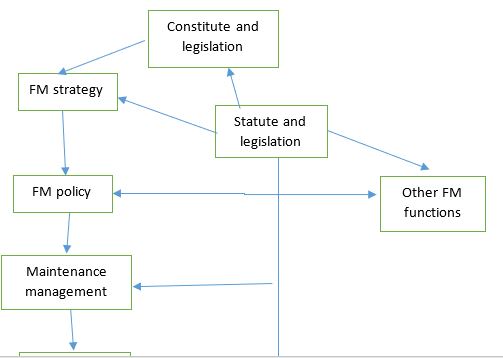
Figure 3: Building maintenance
Every organization tends to adopt a maintenance strategy based on short, medium or long-term concerns. If an organization owns a stable business then long-term concerns span over more than five years. In contrast, if an organization have a volatile business for example telecommunication industry things evolve frequently. In that case, the organization should be very adaptable on short notice and make a quick move towards new trends. (Horner, El‐Haram and Munns, 1997)
For the current organization, a long-term maintenance strategy is suitable as it owns a very stable business that will last long over the years. The following are some main points for developing a maintenance strategy for the concerned organization.
Maintenance planning: Maintenance activities are categorized into two forms. First is planned which is routine maintenance and the second is unplanned which is related to breakdowns which may happen. All details about planned and unplanned maintenance should be added to manuals and specification documents (Huang and Cai, 2005)
Establish Policies and Objectives: It is essential to make sure that all objectives and goals should be based on the concerns of residents.
Develop Maintenance Strategies: Maintenance strategy and supporting plan should be according to the contractors.
Allocate Resources: It is an important concern that budget and experienced professionals are available for maintenance work.
Document Requirements: Key documentation should be available and a building user guide should be circulated among stakeholders to let them know that maintenance objectives are clear.
Monitor Progress: Looking into daily updates and measuring the progress of the maintenance work is important
Energy and Overall Efficiency Retrofits
An energy efficiency retrofit is a very complicated and dynamic process. It includes many steps with a continuous effort to maintain retrofit benefits. As every building is different from the other there is no shared standard for retrofits. For high-rise residential buildings following considerations are important.
Renewable Energy Installations: Renewable energy stuff for example photovoltaic panels are not very costly as they need very small space for installation.
HVAC Management Strategies: Heating, ventilation and air conditioning (HVAC) is an important consumption of energy in high-rise residential buildings as it uses one-third of total electricity. Some major steps to save energy for HVAV are:
- Assessment of HVAC settings and tuning it
- Select accurate working hours
- Select realistic space conditions.
- Finest start/stop routines.
- Mount Variable Speed Drives on pumps and fans
- Mount CO monitoring to manage the intake of fresh air
Building System Tuning: As a building gets older, its different systems tend to show less efficiency (Noor and Pitt, 2009). Therefore tuning of buildings is required to maintain HVAC and electrical systems for performance optimization. To maintain long-term energy efficiency performance, the following facts are important.
- Adjusting controls of thermostats and sensors
- Adjusting working schedules
- make sure all equipment is working
- Following up on maintenance schedules
Power Factor Correction: It ensures that a specific equipment is effectively using electricity. Some equipment uses more power than others, which causes some extra bills that are not mentioned in the tariff. This fact is represented as the ratio of power consumed to the required current flow. 1.0 power factor is the most accepted and error-free (Noor and Pitt, 2009).
Controls Strategy: It deals with monitoring of thermal comfort, and temperature set points so that energy consumption of the building can be controlled.
Peak Demand Management: Peak demand management is concerned with reducing electricity consumption in peak times and exploiting consumption during off-peak. This is an efficient way to know about the load reduction that helps facility managers make cost savings decisions.
Thermal Mass: High-rise residential buildings have a heavy structure which incorporates managing cooling and heating. For example, attaching a motion sensor to stairs can help in cooling when stairs are not in use.
Lighting: It is a reasonably cost-saving practice to provide light in the common areas, which ultimately reduces the cost of HVAC. It is known, that energy consumption in a high-rise building is very high. Studies showed that it is entirely the responsibility of facility management to look over energy consumption and make sensible decisions. As energy management has always been a part of the facility management strategy of any organization this practice is well managed in the facility management plan.
Facilities Manager
The facilities Manager is the key person who manages, monitors and synchronizes intentional and working strategies of the facilities and buildings. The manager makes sure that all functions related to physical features are going well as well as develops a sustainable environment for the residents. A facility manager could be a single person or a team that is working in a shared location. These can be outsourced or in-house either as a single person or a team. The major responsibility of the facility manager is to fulfil the expectations of the consumers by providing information, and support, resolving issues, and understanding needs to ensure an excellent living environment for the inhabitants. A facility manager also deals with third parties for various operations related to building maintenance. In the case of high-rise residential buildings, the facility manager is also supposed to manage a group of people who work under his supervision for multiple operations so he must have managerial skills. According to the latest trends, Skills for facility managers are divided into two types as given below: (Tucker, 2007)
Hard Skills
- Electrical cabling
- power supply
- Woodwork
- Sanitation
- managing HVAC (heat water air conditioners)
- Longitudinal Planning
- Civil and structural engineering principals
Soft Skills
- Client Relations
- management and support for contractors
- Team-building
- Technical analysis
- Time Management
- Business Steadiness
- Economic Responsiveness
There are some significant responsibilities assigned to members of the facility management team which could help out organization to achieve its major goals. Some of them are described in the following section: (Tucker, 2007)
Cleaning: Cleaning also comes under the supervision of the facility team. They can make it according to their pre-defined schedule.
Operational: These include daily operations continued within the building including help desk activities.
Health and safety: The facility management team is responsible to monitor and control the safety of the people and buildings. If they face any failure in their work, it leads to dissatisfaction and public-related issues.
Fire safety: The facility management department is supposed to face more risks and dangers to the lives of inhabitants. FM team has to take care of all fire safety equipment and keep their records up to date.
Security: The FM team is also responsible for providing security for its organization specifically for hardware maintenance.
Maintenance, testing and inspections: The FM team is required to maintain a schedule for its various tasks so that risk can be minimized and major objectives can be achieved.
Contracts: The facilities management team is also responsible for revising the contracts they have done with third-party service providers.
Commercial property management: The FM team also manages property ownership and contracts.
Business continuity planning: The facilities management team also looks after the organization in case of moving the business to a retrieval site.
Conclusion and Recommendations
Facility management stands as a burgeoning and crucial facet of business operations, aiming to enhance an organization's core functions. Providing comprehensive information about facilities is paramount for organizational transparency. The current facility management strategy employed by the client organization appears somewhat abstract, warranting the formulation of a more detailed and effective approach tailored to its specific needs. To achieve success, the collaboration of the facility management team is essential, particularly in the realms of building maintenance and energy management.
Recommendations for the client organization include:
- Adopting a Comprehensive Facility Management Strategy: The current strategy lacks depth and should be restructured to encompass a more organized and extensive approach, integrating industry best practices.
- Enhancing Facility Management Integration: The organization should focus on a more detailed integration of best practices within its facility management strategy to ensure a holistic and effective approach.
- Establishing a Dedicated Facility Management Team: Given the organization's expansive business scope, the creation of a dedicated facility management team is imperative. A single individual may struggle to manage the extensive list of facility management tasks efficiently.
- Formulating a Building Maintenance Strategy: The client organization should develop a concrete and detailed plan for building maintenance. The current abstract planning approach needs refinement to ensure the longevity and efficiency of facilities.
- Implementing a Robust Energy Management Plan: In the context of high-rise residential buildings, addressing energy consumption is critical. A well-defined energy management plan can not only contribute to sustainability goals but also yield significant cost benefits for the organization.
By incorporating these recommendations, the client organization can elevate its facility management strategy, fostering a more efficient and streamlined approach that aligns with its business objectives and contributes to overall improvement.
References
Al-Tamimi, N. and Fadzil, S. (2012). Energy-efficient envelope design for high-rise residential buildings in Malaysia. Architectural Science Review, 55(2), pp.119-127.
Good practice guide on facilities management (1998). Property Management, 16(1).
Alexander, K (2003) A strategy for facilities management, Facilities, Vol. 21, No. 11/12, pp. 269-274
Alexander, K. (1996) (Eds) Facilities Management: Theory and Practice, E & FN Spon, London
Atkin, B & Brooks, A (2009) Total facilities management, 3rd Edition, Blackwell Publishing Ltd, Oxford
Barrett, P.S & Baldry, D. (2003) Facilities management: towards best practice, 2nd edition, Blackwell Publishing Ltd, Oxford.
Barret, P. and Finch, E. Facilities Management: The Dynamics of Excellence, 3rd Edition, Blackwell Publishing Ltd, Oxford
British Standards Institution (2010). BS 11000-1:2010 Collaborative Business Relationships - Part 1: A Framework Specification. London, British Standards Institute
Ellram, L. M. (1995). "A Managerial Guideline For The Development And Implementation Of Purchasing Partnerships." Journal Of Supply Chain Management, 31(2), 9-16.
Horner, R., El‐Haram, M. and Munns, A. (1997). Building maintenance strategy: a new management approach. Journal of Quality in Maintenance Engineering, 3(4), pp.273-280.
Huang, Z. and Cai, S. (2005). Developing Medium and Small Technological Enterprises in China. International Journal of Enterprise Information Systems, 1(4), pp.20-38.
Johnson, J. L. (1999). "Strategic Integration In Industrial Distribution Channels: Managing The Interfirm Relationship As A Strategic Asset." Journal Of The Academy Of Marketing Science, 27(1), 4.
Kadefors, A., And Bröchner, J. (2004). "Building Users, Owners And Service Providers: New Relations And Their Effects." Facilities, 22(11/12), 278-283.
Kaya, S, Heywood, C.A, Arge, K, Brawn, G, Alexander, K (2004) Raising facilities management’s profile in organisations: developing a world-class framework, Journal of Facilities Management, Vol. 3, No. 1, pp. 65-82
Lambert, D. M., And Knemeyer, A. M. (2004). "We're In This Together." Harvard Business Review, 82(12), 114-124.
Lee, H. and Scott, D. (2009). Overview of maintenance strategy, acceptable maintenance standard and resources from a building maintenance operation perspective. J Build Apprais, 4(4), pp.269-278.
Loosemore, M., And Hsin, Y. (2001). "Customer-Focused Benchmarking For Facilities Management." Facilities, 19(13/14), 464-476.
Mallen, C. and Chard, C. (2012). “What could be” in Canadian sports facility environmental sustainability. Sport Management Review, 15(2), pp.230-243.
Macbeth, D. K. (1994). "The Role Of Purchasing In A Partnering Relationship." Journal Of Purchasing And Supply Management, 1(1), 19-25.
McLennan, P (2004) Service operations management as a conceptual framework for facility management, Facilities, Vol. 22, No. 13/14, pp. 344-348
Noor, M., And Pitt, M. (2009). "A Critical Review On Innovation In Facilities Management Service Delivery." Facilities, 27(5/6), 211-228.
Pitt, M & Hinks, J.(2001) Operating and managing the FM: PM interface, Facilities, Vol. 19, No. 7/8, pp. 304-308
Price, I (2004) Business critical FM, Facilities, Vol. 22, No.13/14, pp. 343-358
Shah, S (2007) Sustainable practice for the facilities manager, Blackwell Publishing Ltd, Oxford
Tay, L & Ooi, J.T.L (2001) Facilities management: a “Jack of all trades”?, Facilities, Vol. 19, No. 10, pp. 357-362
The Social Responsibility Research Network. (2012). Social Responsibility Journal, 8(1).
Tucker, M and Pitt, M (2008) Performance measurement in facilities management: driving innovation? Property Management, Vol. 26, No. 4, pp. 241-254
Tucker, M and Pitt, M (2009) Customer performance measurement in facilities management: a strategic approach, International Journal of Productivity and Performance Management, Vol. 58, No. 5/6, pp. 407-422
Wiggins J.M (2014) Facilities Manager’s Desk Reference, Wiley Blackwell, Oxford
Wood, B. (2009) Building Maintenance, Wiley Blackwell, Oxford
Wordsworth, P. (2000) Lee’s Building Maintenance Management, Blackwell Publishing Ltd, Oxford
Waheed, Z and Fernie, S (2009) Knowledge-based facilities management, Facilities, Vol. 27, No. 7/8, pp. 258-266
Yiu, C.Y (2008) A conceptual link among facilities management, strategic management and project management, Facilities, Vol. 26, No. 13/14, pp. 501-511
Zawawi, E., Kamaruzzaman, S., Ithnin, Z. and Zulkarnain, S. (2011). A Conceptual Framework for Describing CSF of Building Maintenance Management. Procedia Engineering, 20, pp.110-117.
Get 3+ Free Dissertation Topics within 24 hours?

















